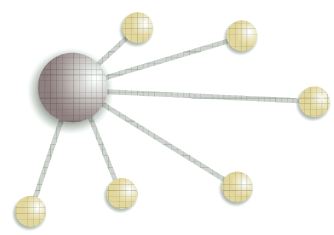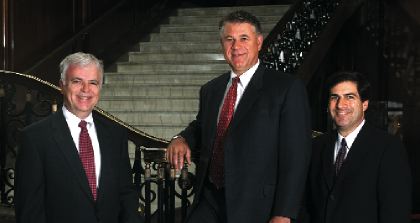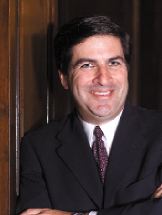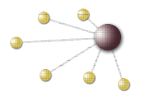
A decentralized structure and focused growth strategy
make HUB International a powerful contender
By Elisabeth Boone, CPCU

If you're familiar with the airline industry, you know that the major carriers operate on a so-called "hub and spoke" system under which operations are based at one airport and a smaller presence is maintained at other locations at which flights are offered.
The hub and spoke approach is proving to be a highly successful strategy for leading North American brokerage HUB International Limited, which was formed in 1998. Since then the firm has acquired more than 90 brokerages in the United States and Canada and has established a strong presence in the northeastern, midwestern, and western United States and in the Canadian provinces of Ontario, Quebec, and British Columbia.
Through a combination of acquisitions and organic growth, HUB increased its revenue from $38.7 million in 1998 to $220 million in 2002. The trailing 12-month revenue as of September 30, 2003, was $271 million, with 85% of the growth attributable to acquisitions. Targeting middle market business, HUB uses multiple distribution channels to provide property, casualty, life and health, employee benefits, investment, and risk management products and services from more than 120 locations across North America. Through partnerships with more than 250 insurance carriers, HUB writes business on both an individual and group basis for a wide variety of risks. (For a complete listing, see the sidebar on page 122.)
HUB is organized with a corporate office and 11 larger regional offices called hubs. These hubs manage and acquire smaller brokerages (fold-ins) that expand the hubs' geographic reach and market share. The hub structure allows the firm to respond quickly to regional market variations and client needs while at the same time centrally managing growth and profitability.
Regional powerhouses
What were the motivating factors behind the creation of HUB International in 1998? "At that time, we recognized that there was a growing number of public brokers in North America, and a significant number of banks were entering the insurance marketplace," explains Bruce Guthart, president of HUB's U.S. operations and formerly president of Kaye Group Inc., HUB's New York-based brokerage. "In addition, agencies were challenged with investing in and managing emerging technologies. HUB's strategy was designed to take advantage of these developing trends, offer an alternative to the traditional mega broker model, and take HUB agencies to a new level," he continues. Other factors were issues of succession, access to capital, access to markets and strength in the marketplace, and the synergies that could be generated through consolidation.

In Canada, the 11 original brokerages were consolidated, and subsequently HUB acquired more than 45 additional agencies; all of these have been consolidated and are managed through four operating hubs for property and casualty business. A fifth hub is a wholesale life and mutual fund operation.
"Our approach has been to develop regional powerhouses, and thus the name HUB," says Richard Gulliver, president of HUB International. "Our strategy from day one has been to establish a strong core of operating capabilities in one center and then to buy agencies and fold them into regional hubs. In doing so, we seek whatever strengths we can gain from critical mass and leveraging scale."
U.S. footprint
HUB International next turned its attention to expanding into the United States. HUB completed its first acquisition in late 1999, bringing in Mack & Parker, Inc., of Chicago and its president, Martin Hughes. Hughes now serves as chairman and chief executive officer of HUB International and also is chairman of Mack & Parker. Hughes was instrumental in bringing on board Bruce Guthart.
"Our U.S. operation is similar to that in Canada, using a regional strategy," Guthart says. "The firms that we look to acquire as hubs are those where the management team has developed a successful operating strategy in that part of the country and knows that region. We don't want to come in after the acquisition and restructure the firm; the reason we acquired it is that its people know how to run the operation. We want to perform functions that they may not be large enough to handle independently, like supplying financial management and capital for acquisitions, providing information technology support and other back-office functions, developing a long-term strategy, and enhancing their insurance company relationships. We want to handle these functions so that each regional hub can continue to focus its resources on being a sales organization, because that's what our business is all about: selling business and servicing clients."
This approach, Guthart says, helps differentiate HUB from its competitors in the U.S. marketplace. "We can go into a new region and offer a large brokerage firm an opportunity to use our platform in that part of the country," he says. "For example, when we acquired a firm in Boston, it was our first New England operation. We let the principals know that we were impressed with what they were doing and we liked their management team. We did not intend to reduce their staff. We intended to take over their back-office functions and allow them to focus on sales and service. In addition, we would provide capital to acquire other agencies in their region and merge them into the hub operation."
HUB International currently operates six regional hubs in the United States. They are located in New York, Boston, Chicago, Los Angeles, Battle Creek, Michigan, and Evansville, Indiana. Each hub, Guthart explains, develops its own local underwriting relationships. "These relationships are important because sometimes the most successful carriers in a particular area are the regional insurers. When we need to work with a national insurer like Chubb, Hartford, or AIG, we develop an overall plan with that carrier." That is a major responsibility held by John Curran, HUB International's vice president of marketing.
"On the one hand, we are highly decentralized," Curran notes. "On the other hand, we try to leverage our scale with insurance companies to achieve a preferential position with them that is beneficial to both parties. We work with insurance companies to develop a business plan that will help us both accomplish our objectives."
Distribution channels
HUB International, as noted earlier, uses multiple channels to distribute its products. "In the United States, approximately 88% of our business is retail, where we sell the insurance product directly to the buyer," Guthart says. "The other 12% is wholesale. Our U.S. wholesale operation trades under the name Program Brokerage Corporation and it's based in the New York City area and in Rhode Island. Program Brokerage distributes and manages programs throughout the northeast on behalf of insurance companies. The unit also sells pure excess and surplus lines business through more than 1,000 independent agents. Our west coast operation acts as the wholesaler for a nationwide program that covers about 4,000 churches."
 "We offer an alternative to the traditional mega broker model and take HUB agencies to a new level."
"We offer an alternative to the traditional mega broker model and take HUB agencies to a new level."
--Bruce Guthart, President of HUB's U.S. operations
HUB also has developed programs for restaurants, residential real estate owners, contractors, funeral directors, publishers, independent telephone companies, and others. More than 75 specialty programs are available both directly and indirectly through retail agents and brokers. HUB's flagship program, which is written on a direct rather than a wholesale basis, provides coverage to more than 46,000 members of the American Veterinary Medical Association throughout the United States. In Canada, a unit called TWIG (The Wholesale Insurance Group) offers programs for greenhouses, liquor liability, lawyers professional liability, trust fund protection, jewelers and furriers, bar and restaurant entertainment, environmental risks, yachts, and other classes. As in the United States, just over 10% of HUB's Canadian business is wholesale, and it works with some 3,000 retail agents.
The HUB "advantage"
How does HUB International, with its 11 regional hubs and more than 120 offices, seek to position itself in the marketplace?
"Our principal focus is on middle market business," Guthart says, "but we also handle a significant volume of small accounts through our select unit, and we have a large number of risk management accounts that generate commission income in seven figures with corresponding premiums in the millions. Our bread and butter is the middle market insurance buyer where the CEO or the CFO is the one who makes the insurance purchasing decision." HUB defines middle market business as accounts that generate between $5,000 and $250,000 in annual commission and have between 50 and 1,000 employees. HUB International offers not only property and casualty products but employee benefits. In addition, HUB handles personal insurance for the corporate executives of commercial clients, as well as personal insurance on a transactional basis in certain parts of the country. "Through our personal lines practice, we're one of the larger private client providers, serving high net worth individuals throughout the country," Guthart remarks.
Citing another key competitive advantage, Curran says, "We have become one of the major players on both sides of the U.S.-Canadian border. There is $1.4 billion worth of transactions every single day between the U.S. and Canada, and we're positioned to serve this market. Where we have capability on both sides of the border, we're able to accommodate those middle market businesses that conduct cross-border operations." Canadian regional insurers, Curran says, "prefer not to take on risks in the United States, so that's one of the advantages of having agencies on this side of the border that can offer solutions to clients that do business across the border." A recent key acquisition, Curran says, was Cross Border Underwriting Services (CBUS), located in Toronto, Ontario. "Their whole reason for existing is to handle cross-border business," he notes.
Scale is another advantage HUB International brings to the marketplace, Curran points out. "HUB International is among the top 15 to 20 agencies with several carriers, so we really work at developing those relationships and building scale in them. This helps us in the marketplace at a time when a lot of the major insurers are looking to contract their distribution systems, and at the same time are seeking alternatives to the big international brokers," he says. "These carriers often turn to us as a leading middle market broker that is highly decentralized so decisions can be made locally. We're very nimble in that regard."
Yet another advantage is cited by Gulliver. "From day one, we've tried to focus on acquiring firms we believe are of the right mindset to be good partners, and that also bring some strategic value in terms of specialized expertise," he says. "We've expanded in those areas and developed practices devoted to them. The practice leaders are producers who have expertise in specific classes and can be accessed by anyone in the HUB organization. This gives us a unique advantage when we're competing in those markets." HUB has specialty practices in employee benefits consulting; wealth management; environmental risk management; financial institutions; global risk solutions; captives and risk financing; real estate; lawyers professional liability; and management liability.
With its wide-ranging regional network, HUB International is ideally positioned to have its finger on the pulse of the property/casualty marketplace. "In both the U.S. and Canada, we have monthly marketing teleconferences," Curran says. "The people who are responsible for placing business discuss difficult risks and possible solutions so they can place accounts appropriately, whether it's for reasons of capacity, pricing, or competition." Adds Gulliver, "Collaboration between operating centers has become a strong part of our culture."
Sizing up potential hubs
What criteria does HUB Inter-national seek when considering the acquisition of a potential hub? "Right now we're targeting expansion in the southeastern United States, the southwest, and the west coast," Guthart says. "We're looking for hubs that have somewhere in the neighborhood of $10 million in commission volume. They could have less, but what we really want is an operating team in place that has grown the business organically as well as through acquisitions so they can continue that process for us in that part of the country. Ultimately we want to expand to probably 15 hubs in the United States, acquiring an average of two hubs per year," Guthart explains. "While there are about 30,000 insurance brokerages in the United States, there are approximately 200 that would meet our criteria for a hub, and those are the firms we're looking at."
Any hub, as mentioned earlier, can acquire an agency and fold it into the hub. "We look to the hubs to locate potential acquisition candidates and manage the process," Guthart says. "Michael Sabanos is director of mergers and acquisitions. He works with HUB's president, Richard Gulliver, whose primary responsibility is leading our M&A activities. Together they identify new hubs and work with the existing hubs to structure a deal when they find an agency to acquire."
Depending on the circumstances, a newly acquired hub may or may not retain its identity after becoming part of HUB International. "Sometimes a hub we're acquiring has a specific identity that is extremely important, so we leave it in place for a period of time," Guthart says. "For the most part, the fold-ins carry the name of the hub."
Fierce competitor
What strategic initiatives does HUB International plan to pursue over the next few years? "Our number one priority going forward will be to build what we call a 'fierce competitors' environment," Gulliver responds. "We're focusing strongly on our sales operation and strengthening the sales culture throughout the organization. In line with that, we'll start to focus more on branding and building our identity as one of the strongest middle market players in the country. Of course, we're always looking at increasing our margins through synergies and integration."
Additional resources will be channeled into an initiative called HUB Academy, which was established to support the development of a sales culture. "All the brokerages that came into HUB had very capable sales organizations and strong track records as entrepreneurs who were growing their operations," Gulliver explains. "We're working with those sales leaders to take these strengths to a new level. As individual entities, we could not invest significant resources in certain areas because we didn't have the scale. One of those areas was developing producers and CSRs on an ongoing basis.
"In 2002 we launched HUB Academy. We work with the presidents of our hubs to identify, recruit, and train the right sales professionals," Gulliver says. "The academy offers a three-phase program that focuses first on understanding the local operating center and HUB International as a company, our strategies and our visions. For Phase 2 we put people through an intensive three-week training school to educate them in insurance and risk management as well as product knowledge. In Phase 3, participants attend a two-week session in Canada that focuses on developing sales skills." Other elements of the initiative are team building, networking and presentation skills, and public speaking programs.
"Once our salespeople have gone through HUB Academy, they go back to their local operation and work with a mentor to develop into producers," Gulliver says. "We have a similar program to train and educate CSRs."
Through the initiatives of HUB Academy, "Our goal is to find young people, sometimes right off college campuses, and help them become part of our dynamic sales organization," Curran says. "We're aiming to become younger and more diverse so we can be more responsive to the marketplace."
Energetic, focused, and disciplined, the leaders of HUB International are enthusiastic about the future and committed to being top players in a tough field. Through organic growth and a measured program of acquisitions, these entrepreneurs are determined to bring winning solutions to the hungry middle market. *
HUB International Program Offerings

Accountants
Aquaculture
Architects and engineers
Attorneys
Automobile dealers
Biotechnology
Churches and synagogues
Contractors
Construction
Conventions and events
Credit unions
Drilling
Dry cleaners and Laundromats®
Environmental
Financial institutions
Fine arts dealers
Fisheries
Fuel, oil, propane, and gas dealers
Government agencies and institutions
Greenhouses
Health care
Hospitality
Jewelry and furs
Labor organizations
Logging
Manufacturing
Medical device manufacturers
Museums
Mushroom growers
Real estate
Rental equipment
Retirement and extended care facilities
Pharmaceutical manufacturers
Pleasure craft
Security
Teachers
Technology
Transportation
Veterinarians
For more information:
HUB International Ltd.
Phone: (877) 402-6601
Web site: www.hubinternational.com